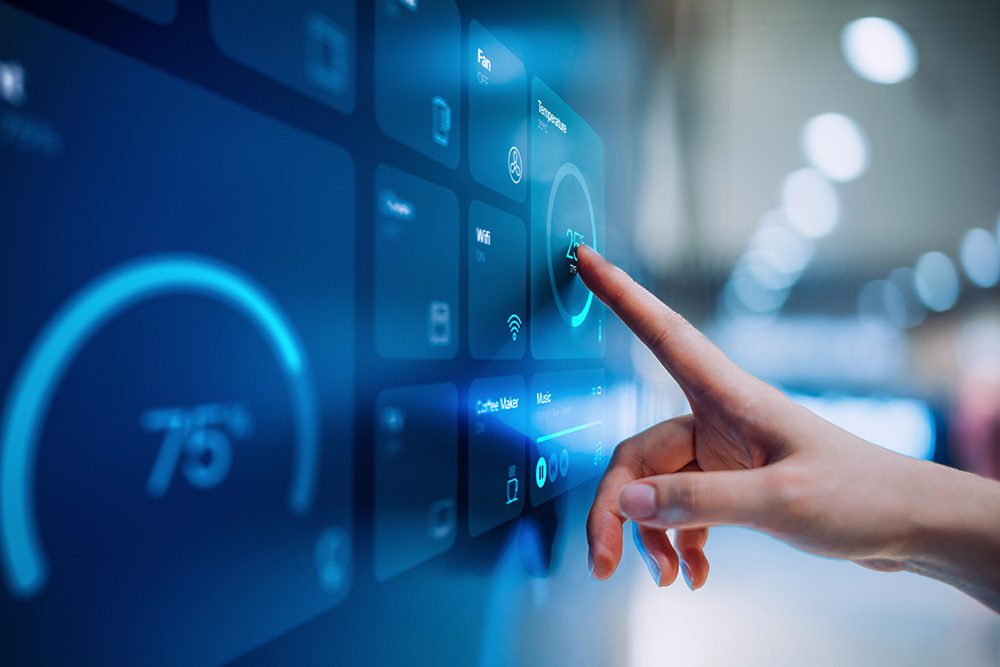Smart buildings are no longer a niche market. Rising energy costs and a targeted focus on emissions reduction have underscored the importance of resource management. As a result, more than 115 million smart buildings are expected to be operational by 2026 – a 150% increase from 2022. This incredible growth highlights the critical importance of digitalization in innovative building design.
Utilizing embedded smart sensors, digital twins, automated monitoring systems, and advanced data analytics in the building design is key to meeting sustainability goals. These integrations transform energy management, enhance sustainability, and improve operational reliability throughout a building’s lifetime.

Digitization or digitalization?
However, it’s imperative to understand the difference between power digitization and digitalization. Power digitization refers to converting analog data into a digital format, such as moving from paper records to digital ones.
Power digitalization, however, takes that digitized data to the next level. Procured from embedded IoT (Internet of things) sensors, digital twins, and automated monitoring systems, the data is leveraged to provide:
- Optimized energy efficiency: Real-time adjustments based on data analytics reduce waste and lower costs. Automated smart systems regulate lighting, heating, and cooling based on occupancy and usage patterns.
- Enhanced sustainability: Advanced monitoring tracks and manages carbon footprints, ensuring compliance with environmental regulations. Data-driven insights identify inefficiencies and recommend improvements, supporting green building certifications and reducing overall environmental impact.
- Operational reliability: Predictive maintenance through continuous monitoring and automated alerts helps prevent failures and reduces downtime. Proactive identification of potential issues in electrical equipment allows for timely interventions before problems escalate.
- Advanced data analytics: Provide deeper insights into energy consumption patterns, power quality, and operational performance. Leveraging analytics informs decision-making, optimizes resource allocation, and improves building management.
Practical implementation strategies in new smart building designs
Digitalization also has the benefit of future-proofing smart buildings for technologies we have yet to consider.
Some key strategies ensure a building’s electrical infrastructure is designed for performance, informed decisions, and future technologies from the beginning.
- Early integration: It is crucial to incorporate power digitalization during the initial design phase. Strategically placing smart sensors, IoT devices, and monitoring systems at optimal points within the electrical infrastructure helps avoid the complexities of retrofitting existing buildings.
- Proactive planning: A comprehensive digitalization strategy that includes future-proofing considerations should address emerging technologies, industry standards, and potential scalability requirements. For example, incorporating infrastructure for eMobility charging stations from the outset ensures compliance with evolving building codes. It also supports future electric vehicle adoption.
- Digital twins and design tools: These advanced tools streamline the implementation process. Digital twins create a virtual replica of a building’s power system, enabling designers to simulate and optimize performance before construction begins. They also support the concept of a “live digital twin,” where the digital model remains updated with real-time data from the building’s systems. This allows for continuous optimization and future scalability.
Power digitalization applied in real-world cases
At Hexeis, we have been at the forefront of numerous successful power digitalization projects, leveraging our expertise and innovation in real-world applications.
For example, we worked with a hospital in Brisbane that faced significant delays in a car park project due to overestimated power demand – primarily for electric vehicle (EV) chargers. We leveraged digitized data from an existing car park, and with that, the project team corrected the consultants’ overestimations. This adjustment allowed the hospital to use the existing substation capacity. It saved hundreds of thousands of dollars and avoided a six to eight-month delay—making this an informed, cost-effective decision directly resulting from power digitalization.
Another hospital required a power system upgrade to improve resilience. Due to their fully digitized circuit breakers and comprehensive data collection since 2011, they saved approximately $400,000 (AUD) during the engineering study phase. The existing data allowed for a detailed and accurate redesign, and the project ended up a few million dollars cheaper than initially estimated.
Future trends and technologies for innovative building design
As smart buildings become the norm, advances in artificial intelligence (AI) and machine learning (ML) will continue to shape power digitalization. These technologies will undoubtedly enhance the capabilities of digital twins and automated monitoring systems and enable more accurate predictions and proactive maintenance.
The integration of IoT devices will also expand, allowing for more comprehensive data collection and analysis. New trends include the development of more intelligent energy storage solutions and grid-interactive efficient buildings (GEBs) that optimize energy use dynamically. Together, these innovations will enhance energy efficiency, sustainability, and operational reliability in building designs in the future.
Partner with an expert advisor
As an EcoXpert Master Partner in Power Management, Hexeis fully utilizes Schneider Electric’s global strengths. We incorporate their deep expertise in energy and automation and look to their digital solutions for efficiency, sustainability, and resilience. This includes complete solutions for power management services, systems, and metering devices.
We can help you see the bigger picture and understand power digitalization’s impact on your facilities, operations, and decarbonization goals. We can advise you on greenfield or brownfield projects and help consultants write design guides. Our team can also help you justify sustainability investments to your executives and get the most from your efforts.
To learn more about how to optimize your facility’s decarbonization using power management solutions, visit https://www.se.com/ww/en/work/solutions/power-management/.
To learn more about how Hexeis provides industry-leading energy analysis, monitoring, and management solutions, visit hexeis.com.
EcoXperts are the enablers of net-zero buildings
The EcoXpert Partner Program is unique and comprises a best-in-class, global ecosystem of expertise. Trained and certified by Schneider Electric, EcoXpert partners digitize and electrify our world for a more sustainable future.
The path to net zero is about delivering solutions for sustainable, resilient, efficient, and people-centric buildings. For our EcoXpert partners, this unveils immense growth opportunities through the transition to end-to-end portfolio sales that will resolve our customers’ most critical needs. For our shared customers, this means that together with our EcoXpert partners, we will drive the building industry transformation and help our customers survive and thrive today – and tomorrow.




Add a comment